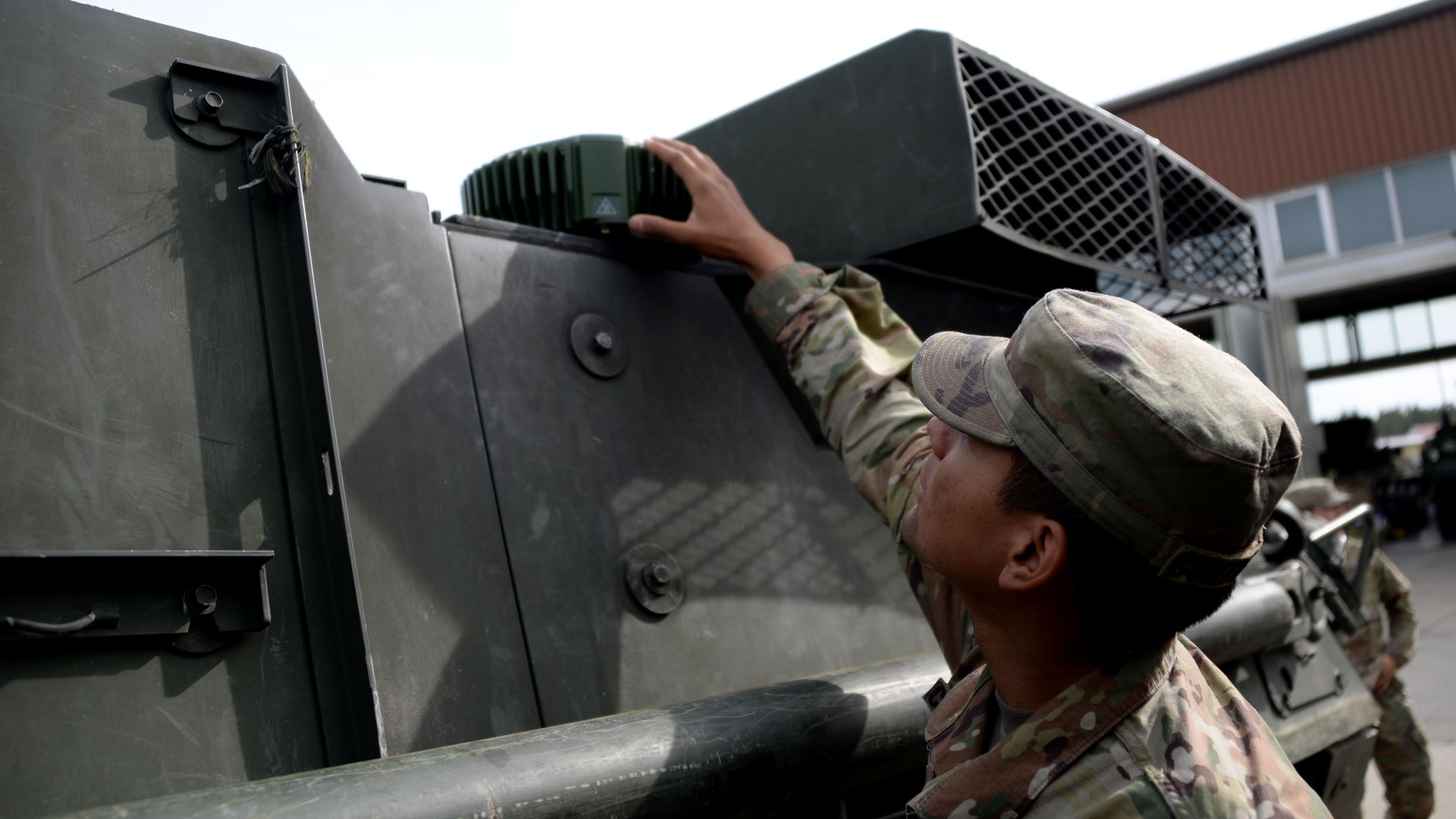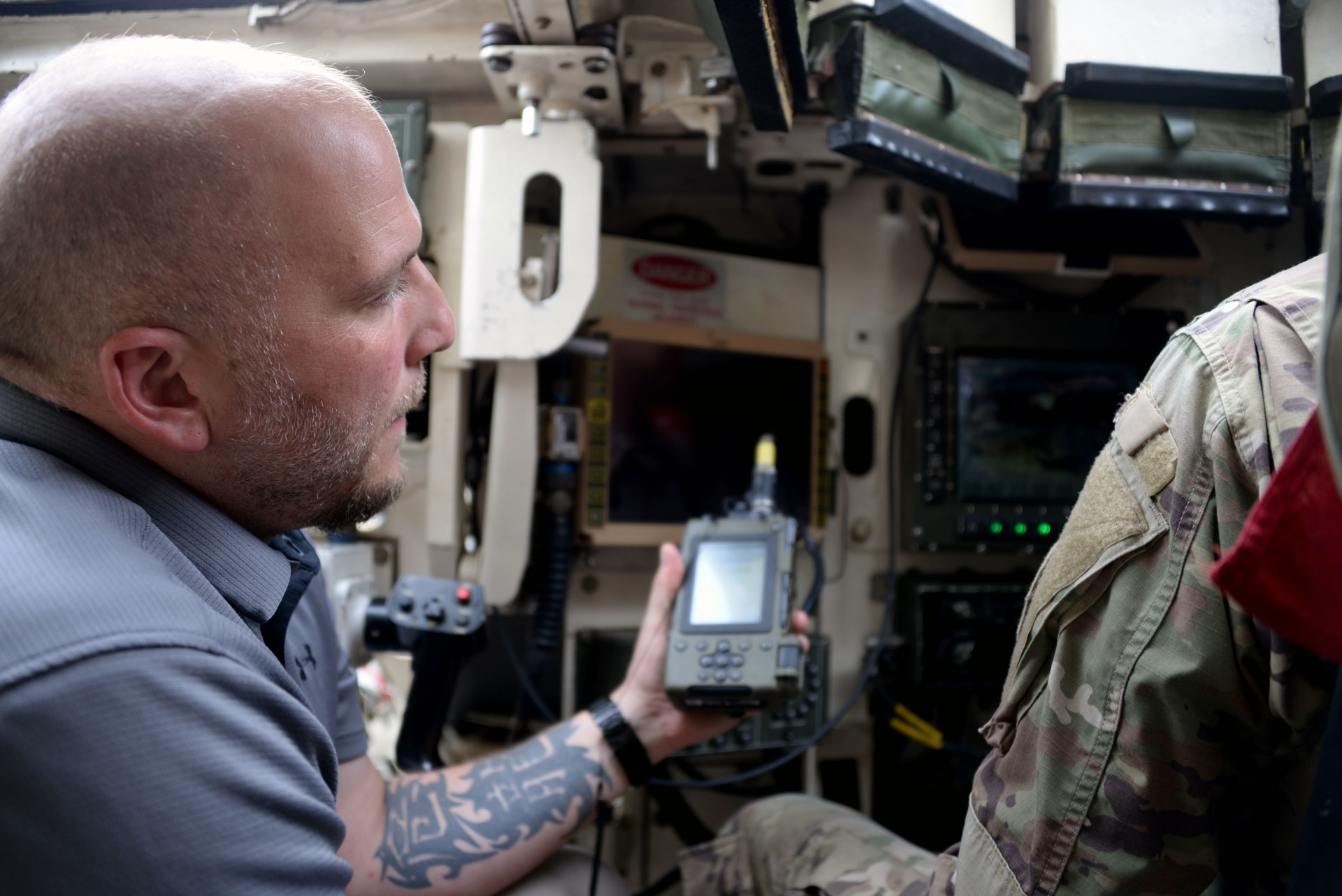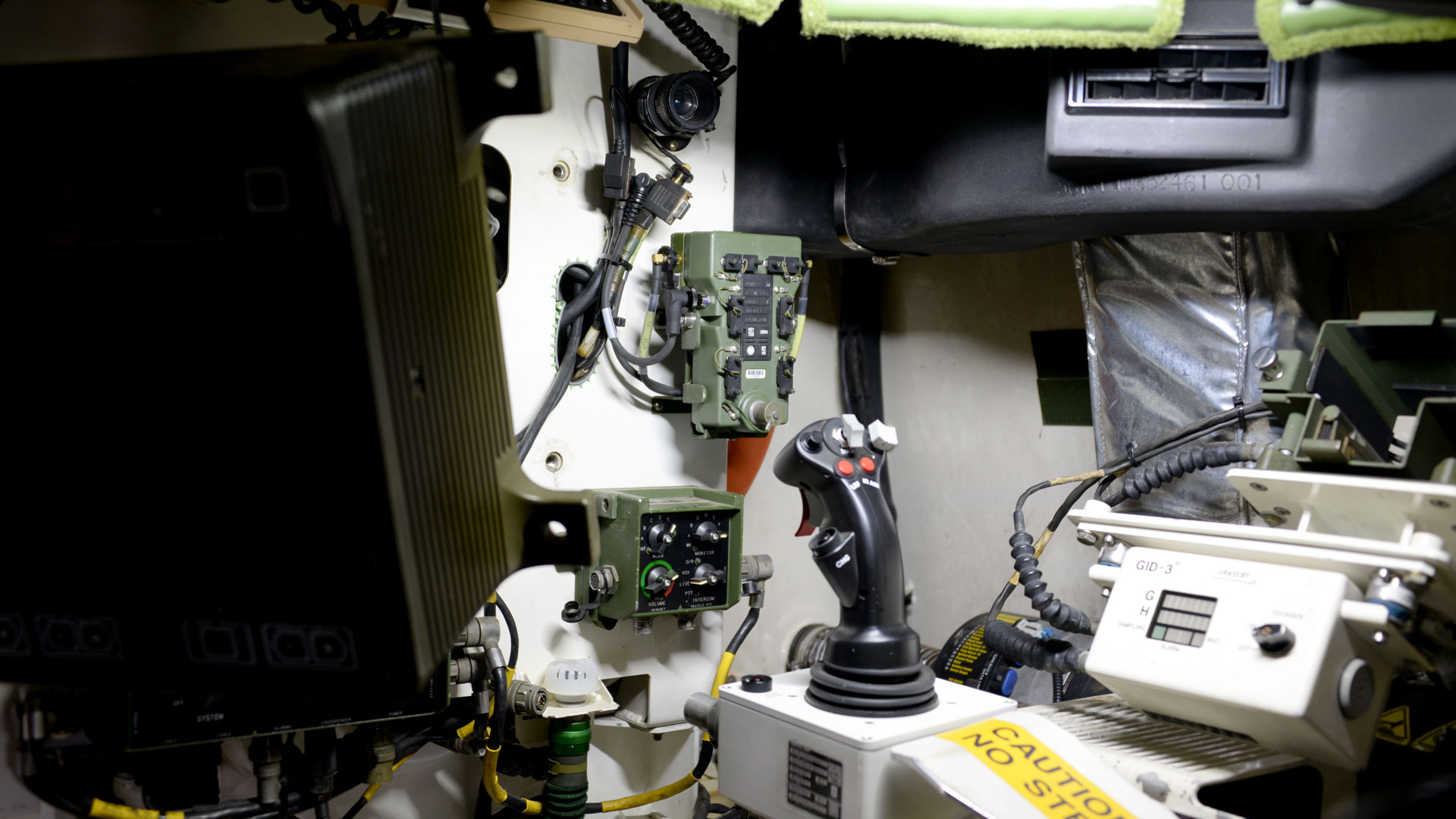
Army Modernization Strategies inform equipping of new position, navigation and timing system.
by John Higgins and Caitlin O’Neill
Fortification is key for the military. Fortification ensures not only mission success, but even more critically, that Soldiers come home. For that reason, vehicles are armored, walls are reinforced and surveillance equipment is deployed. Navigation systems get fortified, too: GPS, which can be the cornerstone of navigation during military operations, has been an important tool in a Soldier’s toolkit for nearly 20 years, and is fortified through assured position, navigation and timing (APNT). A new suite of equipment that provides APNT was shepherded to Germany by members of the Project Manager for Positioning, Navigation and Timing (PM PNT) in early September.
PM PNT’s mission was to outfit Soldier vehicles with the latest PNT equipment in cooperation with several stakeholders: U.S. Army Europe; the Project Manager for Stryker Brigade Combat Team within the Program Executive Office for Ground Combat Systems; the chain of command for the 2nd Cavalry Regiment; the APNT Cross-Functional Team; the TRADOC Capability Manager for Tactical Radios; and the mechanics in the Rose Barracks motor pool in Germany. The team’s objective was to outfit the Strykers with the Mounted Assured PNT System Generation 1 (MAPS GEN I), a new tool that allows Soldiers to navigate in locations where GPS capabilities are challenged by such factors as adversarial interference, terrain or weather.

A Soldier with 2nd Squadron, 2nd Cavalry Regiment works with a newly installed component of MAPS GEN I at Rose Barracks, Germany. Members of PM PNT worked with a team of stakeholders to install the new system on Stryker vehicles so that Soldiers could use and provide feedback on the equipment. (U.S. Army photos by John Higgins, Program Executive Office for Intelligence, Electronic Warfare and Sensors)
WITH ALL SPEED
The Army Modernization Strategy charges the APNT Cross-Functional Team and the U.S. Army Futures Command to reduce the time it takes to deliver new weapons systems, which includes a significant reduction of the requirements development process to 12 months or less.
The MAPS directed requirement was approved in January 2019. “There were numerous challenges in developing the MAPS requirement,” said Willie Nelson, director of the APNT Cross-Functional Team. “Because almost all combat and combat support systems require GPS in some way, developing a requirements document that would encompass them, while staying affordable, posed its challenges.”
The initial requirement “took a systems-of-systems approach, which was difficult to get through the Army Requirements Oversight Council and Joint Requirements Oversight Council process,” Nelson said. “That process requires a more ‘big picture’ approach that was cumbersome. Instead, the [cross-functional team] made the decision to break up the large requirement into smaller, focused requirements, and to condense the requirement document to only seven pages in length.”
Breaking down the larger assured PNT requirement into separate requirements—one requirement for a mounted system, and a separate requirement for the dismounted system—made them more manageable and agile. “This makes it much easier to understand, and it took only three months to get the MAPS directed requirement approved, which was a big win for the [cross-functional team], the Army and, most importantly, the Soldier,” Nelson said. Assured PNT has broad functionality, but rather than have all stakeholders design an entire system, APNT development was divided into “apps” that focused on one aspect. Mounted and dismounted functions required different “apps” to meet different user needs and size, weight, power and cost standards, as well as access to different kinds of data.
“The key to the rapid development of the mounted APNT requirement was focusing our documents to bring the most pertinent information forward to decision-makers and users,” said Col. Daniel Kuntz, TRADOC capabilities manager for tactical radios. “We tightly worked with tactical units, materiel developers and testers, coupling technological innovation and operational feedback in order to give our Soldiers the best equipment available.”

Dan Sweet, a trainer with PM PNT, instructs a Soldier with 2nd Squadron, 2nd Cavalry Regiment at Rose Barracks on how to use MAPS GEN I, which allows users to navigate in areas where GPS is degraded or denied.
OTA PAVES THE WAY
“Accelerating the process of developing and fielding the latest PNT capabilities to the Soldier is essential to preserving America’s interests and reassuring our allies throughout the globe,” said Col. Nick Kioutas, project manager for PNT. His organization is using other-transaction authority (OTA) contracts to rapidly develop assured navigation solutions like MAPS GEN I.
Rapid solutions are what OTAs are designed for, as they are independent from the Federal Acquisition Regulation—with other more specific regulations in place—and thus have a greater degree of flexibility. OTAs require at least one nontraditional defense contractor participating to a significant extent in the project or a cost-sharing arrangement under which at least one-third of the cost of the project comes from nonfederal sources. As such, they open the door to smaller companies with greater specialization and focus on certain areas that will enhance military materiel and products without sacrificing on scale.
Each military service has authority to execute OTAs up to $500 million with authorization by their service acquisition executive, and there are no limits on how many OTAs may be executed by the services or the cumulative value of such awards.
Army senior leadership was supportive of the APNT Cross-Functional Team’s nontraditional approach. “Getting this requirement written and approved was truly a team effort,” said Nelson. “Throughout the development and approval process, our priority was to ensure that our Soldiers get the capabilities and systems they need to operate successfully on the battlefield. I’m encouraged by the support we’ve received from our counterparts and senior leaders.”
That support allowed the APNT Cross-Functional Team and PM PNT to incorporate Soldiers and their feedback early on in the requirement development process to ensure operational capability and system functionality that met the needs of the warfighter, provided an advantage to future formations and, most importantly, would inform the training that PM PNT would provide to Soldiers in Germany.
ON THE GROUND TO GET THE JOB DONE
Jim Spofford, assistant product manager for PM PNT, and part of his team spent September overseeing the installation of and training for the components that make up MAPS GEN I. Working out of the motor pool on Rose Barracks, they ensured that technicians had a clear picture of how to install the hardware and the connecting cables and that the hardware was functioning properly.
MAPS simplifies the mounted PNT capability by distributing PNT data to multiple systems directly via a network, eliminating the need for multiple GPS devices on a single platform while allowing multiple users to access a GPS signal from one central point in a Stryker vehicle.
“This is the first time this type of mounted system with APNT has been equipped on these vehicles, giving our warfighters better anti-spoof and anti-jam capabilities than ever before,” said Lt. Col. Alexander “Raz” Rasmussen, product manager for Mounted PNT within PM PNT. “When paired with an AJAS [Anti-Jam Antenna System], it allows our mounted Soldiers to operate in denied environments.”
He added, “This is the first equipping that has been executed under an Army Futures Command-mandated requirement with a cross-functional team. Through our partnership we have been able to produce this capability with unprecedented speed.” Part of that speed was driven by the team on the ground: Each day, the motor pool became more adept at the installation process. When installations started in September, it took four days to install one system on one vehicle; by the end of the month, the MAPS hardware system install would be completed the same day it was started, with multiple vehicles completing installation in the same day, in some cases.
The team also gathered information directly from Soldiers about the equipment once it was installed. “We have learned a lot by way of the 2nd Cavalry Regiment’s Soldier touch points,” said Rasmussen. “From the privates to officers, the feedback on the technology will help shape mounted APNT solutions for years to come.”
Some of the feedback came from interviews with Soldiers during the PNT Assessment Exercise (PNTAX) held in August at White Sands Missile Range, New Mexico. Sponsored by the APNT Cross-Functional Team, the exercise gave Army programs of record, science and technology labs, other government agencies and industry partners the opportunity to participate in live, virtual and constructive prototype demonstrations, using mission threat scenarios to support system and capability analysis and requirements development.
“What makes PNTAX unique is that anyone can participate,” Nelson said. “Military, other government agencies, industry, academia—it doesn’t matter. If you have a technology and you want to assess its ability to operate in a live-sky, GPS-challenged environment, come to PNTAX,” Nelson said.
“We’re getting exposed to stuff that we didn’t ever know existed,” said Staff Sgt. Gregory Lowell, a fire support Soldier who took part in PNTAX. “It’s very cool to see the new threats that we may be experiencing in combat, while at the same time we can provide a lot of feedback to the engineers about details they might not have realized, having not used it in an operational environment.”
Feedback from Soldiers like Lowell was compiled by the Army Futures Command and the U.S. Army Combat Capabilities Development Command in a comprehensive human systems integration report detailing Soldiers’ impressions of early MAPS GEN I prototypes. The report included a system usability scale that compiled Soldiers’ numerical ratings of the equipment and direct suggestions regarding usability and functionality. The goal was to ensure that the hardware didn’t merely accomplish the task, but was able to do so in a way that was “Joe proof”—that it worked in a way that was compatible with how Soldiers are trained to approach problems and use equipment.

A key component of MAPS GEN I is the system is the Enhanced DAGR Distributed Device, which can host up to seven GPS clients from one central point in a Stryker vehicle. Previous systems could host just one.
SOLDIER FEEDBACK INFORMS TRAINING
Training that implemented extensive Soldier feedback reinforced the lessons learned during installation.
Every day in September, other members of PM PNT, with assistance from U.S. Army’s Space and Missile Defense Command, provided extensive new equipment training to two squads to half a platoon of Soldiers daily. The team’s goal was to train roughly a company’s worth of Soldiers before the team left Germany in early October.
Joan Rousseau, chief of the command’s Army Space Training Program Integration, provided a primer on signal power and effects, and Dan Sweet and Ray Johnson, trainers with PM PNT, explained how MAPS provides protection and bolsters capability in denied or degraded environments. Classroom sessions were followed by hands-on experience and troubleshooting with installed MAPS systems.
“This new system is … more flexible than the older DAGR [Defense Advanced GPS Receiver] system,” said Spc. Connor Anderson, an infantryman who took the MAPS GEN I familiarization training. “The old DAGR was only able to serve one client system. MAPS can serve up to seven.”
CONCLUSION
Kioutas and PM PNT are already preparing for the future of MAPS. GEN II “upselect”—or advancing a contract to the next stage of development—has just been awarded via an other-transaction authority, Kioutas said, and will improve the availability and integrity of the system, including signal availability and reliable cross-reference information such as atmospherics and elevation.
The APNT Cross-Functional Team also continues to work on the project, Nelson said, and is leading a modeling and simulation effort that will simulate dynamic GPS scenarios to assess current and emerging APNT, space and navigation warfare technologies. “The primary focus is to baseline how GPS is used for mission thread analyses [complete analyses of an aspect of a mission from start to finish] and assist the Army in determining where complementary PNT sensors will enhance mission effectiveness,” he explained. “This will enable GPS-challenged environments to be transitioned into meaningful mission-effectiveness models that can inform commanders, the requirements community and acquisition managers.” Such models explore how a piece of equipment functions to complete a mission, where it can be improved and what doesn’t need to change.
The information and lessons that the PM PNT team gathered from this equipping mission will be applied for years to come. By ensuring that mechanics and technicians can implement the hardware installation quickly, as well as ensuring the functionality of and training on that equipment, MAPS GEN I will lay the foundation for hardware upgrades for generations of MAPS systems.
For more information, go to https://www.pmpnt.army.mil/, https://www.army.mil/futures or https://www.army.mil/futures#org-about.
JOHN HIGGINS is a public affairs officer with the Program Executive Office for Intelligence, Electronic Warfare and Sensors. He is an Iraq War veteran and former public affairs Soldier. He holds a B.A. in film production from Towson University.
CAITLIN O’NEILL is director for strategic communications and public affairs for the APNT Cross-Functional Team and previously served as the public affairs officer for PM PNT. She has a master of public administration degree from George Mason University and a B.S. in criminal justice from Virginia Commonwealth University.
Subscribe to Army AL&T News – the premier online news source for the Army Acquisition Workforce.
![]() Subscribe
Subscribe







